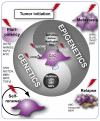Epigenetic regulation of cancer stem cells in liver cancer: current concepts and clinical implications
- PMID: 20646772
- PMCID: PMC3492877
- DOI: 10.1016/j.jhep.2010.05.003
Epigenetic regulation of cancer stem cells in liver cancer: current concepts and clinical implications
Abstract
The two dominant models of carcinogenesis postulate stochastic (clonal evolution) or hierarchic organization of tumor (cancer stem cell model). According to the latter, at the germinal center of tumor evolution is a cancer stem cell (CSC) which, similar to normal adult stem cells, possesses the capacity of self-renewal and a differentiation potential. Over the past few years, compelling evidence has emerged in support of the hierarchic cancer model for many solid tumors including hepatocellular cancers. The CSCs are posited to be responsible not only for tumor initiation but also for the generation of distant metastasis and relapse after therapy. These characteristics are particularly relevant for a multi-resistant tumor entity like human hepatocellular carcinoma and may herald a paradigm shift in the management of this deadly disease. Identification and detailed characterization of liver CSCs is therefore imperative for improving prevention approaches, enhancing early detection, and extending the limited treatment options. Despite the current progress in understanding the contribution of CSCs to the generation of heterogeneity of tumors, the molecular complexity and exact regulation of CSCs is poorly understood. This review focuses on the genetic and epigenetic mechanisms that regulate and define the unique CSC properties with an emphasis on key regulatory pathways of liver CSCs and their clinical significance.
Copyright 2010. Published by Elsevier B.V.
Figures

Similar articles
-
[Progress and prospects in cancer stem cell research for hepatocellular carcinoma].Ai Zheng. 2009 Sep;28(9):1004-8. doi: 10.5732/cjc.008.10835. Ai Zheng. 2009. PMID: 19728923 Review. Chinese.
-
Inhibition of the cancer stem cells-like properties by arsenic trioxide, involved in the attenuation of endogenous transforming growth factor beta signal.Toxicol Sci. 2015 Jan;143(1):156-64. doi: 10.1093/toxsci/kfu218. Epub 2014 Oct 10. Toxicol Sci. 2015. PMID: 25304214
-
Biology and clinical implications of CD133(+) liver cancer stem cells.Exp Cell Res. 2013 Jan 15;319(2):126-32. doi: 10.1016/j.yexcr.2012.09.007. Epub 2012 Sep 19. Exp Cell Res. 2013. PMID: 22999864 Review.
-
Clinical implications of cancer stem cell biology in hepatocellular carcinoma.Semin Oncol. 2012 Aug;39(4):461-72. doi: 10.1053/j.seminoncol.2012.05.011. Semin Oncol. 2012. PMID: 22846863 Free PMC article. Review.
-
Relevant markers of cancer stem cells indicate a poor prognosis in hepatocellular carcinoma patients: a meta-analysis.Eur J Gastroenterol Hepatol. 2013 Sep;25(9):1007-16. doi: 10.1097/MEG.0b013e32836019d8. Eur J Gastroenterol Hepatol. 2013. PMID: 23478672 Review.
Cited by
-
DNMT1 Regulates Epithelial-Mesenchymal Transition and Cancer Stem Cells, Which Promotes Prostate Cancer Metastasis.Neoplasia. 2016 Sep;18(9):553-66. doi: 10.1016/j.neo.2016.07.007. Neoplasia. 2016. PMID: 27659015 Free PMC article.
-
Evidence of distinct tumour-propagating cell populations with different properties in primary human hepatocellular carcinoma.PLoS One. 2011;6(6):e21369. doi: 10.1371/journal.pone.0021369. Epub 2011 Jun 23. PLoS One. 2011. PMID: 21731718 Free PMC article.
-
Activated Carbon nanoparticles Loaded with Metformin for Effective Against Hepatocellular Cancer Stem Cells.Int J Nanomedicine. 2023 May 31;18:2891-2910. doi: 10.2147/IJN.S382519. eCollection 2023. Int J Nanomedicine. 2023. PMID: 37283712 Free PMC article.
-
TrkC-mediated inhibition of DJ-1 degradation is essential for direct regulation of pathogenesis of hepatocellular carcinoma.Cell Death Dis. 2022 Oct 6;13(10):850. doi: 10.1038/s41419-022-05298-3. Cell Death Dis. 2022. PMID: 36202793 Free PMC article.
-
miR-548c-5p inhibits proliferation and migration and promotes apoptosis in CD90(+) HepG2 cells.Radiol Oncol. 2012 Sep;46(3):233-41. doi: 10.2478/v10019-012-0025-z. Epub 2012 Apr 11. Radiol Oncol. 2012. PMID: 23077462 Free PMC article.
References
-
- Bonnet D, Dick JE. Human acute myeloid leukemia is organized as a hierarchy that originates from a primitive hematopoietic cell. Nat Med. 1997;3:730–737. - PubMed
-
- Nowell PC. Clonal Evolution of Tumor-Cell Populations. Science. 1976;194:23–28. - PubMed
-
- Bergsagel DE, Valeriote FA. Growth characteristics of a mouse plasma cell tumor. Cancer Res. 1968;28:2187–2196. - PubMed
-
- Heppner GH. Tumor heterogeneity. Cancer Res. 1984;44:2259–2265. - PubMed
-
- Weisenthal LM, Lippman ME. Clonogenic and nonclonogenic in vitro chemosensitivity assays. Cancer Treat Rep. 1985;69:615–632. - PubMed
Publication types
MeSH terms
Substances
Grants and funding
LinkOut - more resources
Full Text Sources
Other Literature Sources
Medical
Miscellaneous

